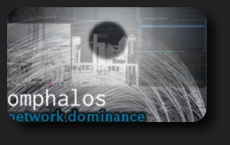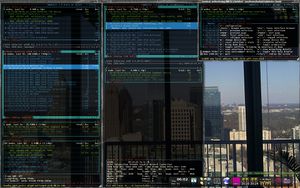Check out my first novel, midnight's simulacra!
Omphalos


A tool for network enumeration, protection, observation and domination. Omphalos makes use of passive and active portscanning, DNS/DHCP/Zeroconf server interrogation, portknock detection, covert channel detection and establishment, ARP scanning, automatic WEP cracking, man-in-the-middling, and a whole host of other tricks. GPS integration? Oh yes. Coordination across multiple interfaces? Of course. Use of Linux's MMAP_RX_SOCKET and MMAP_TX_SOCKET? Wouldn't have it any other way. Userspace networking is made visible to the host via a TUN/TAP device. While designed as an offensive tool, omphalos has proven useful for network debugging and troubleshooting, as well as experimentation.
Omphalos is not a "point-and-click" tool so much as "pull the pin" or perhaps "spray the area". Default behavior is to redirect and seize all traffic, attack weak cryptosystems, archive authentication materials, and learn everything that can be learned. Ideally, a tiny microprocessor would be paired with power and a network device, stealthily physically inserted into a network, and left there; omphalos and liburine would then combine to provide complete network dominance. I hope to combine network programming and the techniques of high-performance computing to create a tool capable of much havoc.
Omphalos: Because one layer is never enough. Code is hosted on GitHub, as are modern issues. Old bugs are still available at bugzilla. There's a mailing list at Google Groups.
Similar Tools
- SSLSNIFF from Thoughtcrime Labs
- ettercap by Alberto Ornaghi and Marco Valleri
- Netdiscover by Jaime Peñalba
- NetworkMiner from NETRESEC AB
- JDisc Discovery from JDisc UG
- LanTopolog by Yuriy Volokitin
- Miranda by Craig Heffner
Countertools
We want to defeat systems like:
- ArpON by Andrea Di Pasquale et al
Subsumed Tools
Omphalos implements all or portions of the functionality of the following tools:
Versions/Milestones/Releases
| Version | Release date | Features |
|---|---|---|
| 0.98 (initial alpha) | 2011-10-07 (actual)
2011-09-23 (planned) |
|
| 0.99.0β (initial beta) | 2011-12-01 (actual)
2011-11-11 (planned) |
|
| 1.0 | 2011-12-25 (planned) |
General Features
Some planned, some implemented...
- Modes of operation governing automatic behavior, from "Silent" to "Hostile":
| Mode | Summary | Operating characteristics |
|---|---|---|
| Silent | Take no actions, only watch. |
|
| Stealthy | Take only the actions of a normally-configured host. | |
| Active | Learn what we can, possibly standing out from the crowd. |
|
| Aggressive | Learn things quickly, in ways that will be noticed. |
|
| Forceful | Actively disrupt the network, rerouting traffic through us. |
|
| Hostile | Attempt to make the network unusable. |
|
- GPS coordination and tagging
- Fully dynamic behavior viz the networking stack. Add and remove cards, routes, addresses...
- Audiovisual plugins (FIXME detail! lots of good ideas here)
- Event/scripting engine
- Full integration with POSIX capabilities for fine-grained security (nothing runs as the superuser)
- Covert channel detection at all layers via Zetetic
- Opportunistic, secure remote control via liburine
Network Analysis
- Network analysis and debugging ought be spun out into Dr. Benway
| Layer | Subdivisions | What's tracked | Notes |
|---|---|---|---|
| Layer 2 | From both packets and netlink:
|
|
|
| Layer 3 | From both packets and netlink:
|
We don't want to track network addresses beyond our broadcast domain. That's difficult to determine, however, without a working routing configuration (ie, an address). We'll thus assume that RFC1918 membership or service of an L2-restricted service (like DHCP or Zeroconf) indicates local presence (if it doesn't, it indicates misconfiguration). This means that
|
|
| Layer 4 | From packets:
|
We don't use the local configuration because there's no unified API to access it, nor track changes to it. We'll detect DNS quickly enough if anything's actually using the network, and can partially detect host DNS servers simply by kicking off a query through the standard resolver library (even if we don't use the provided result). |
Analysis and Attack Capabilities
Physical Layer Support
| Protocol | Standard | libpcap linktype | Linux ARP type | Analyzed? |
|---|---|---|---|---|
| BSD Loopback | ? | DLT_NULL | N/A | No |
| Linux Cooked Capture | packet(7) | DLT_LINUX_SLL | N/A | Yes |
Ethernet
|
IEEE 802.3-2008 | DLT_EN10MB | ARPHRD_ETHER | Yes |
| Token Ring | IEEE 802.5 | DLT_IEEE802 | ARPHRD_IEEE802_TR | No |
| ARCNET | ANSI 878.1 |
|
ARPHRD_ARCNET | No |
| SLIP
(Serial Line Internet Protocol) |
|
DLT_SLIP |
|
No |
PPP (Point-to-Point Protocol)
|
RFC 1661
|
DLT_PPP
|
ARPHRD_PPP | Partial
|
| FDDI
(Fiber Distributed Data Interface) |
|
DLT_FDDI | ARPHRD_FDDI | No |
| Fibre Channel | RFC 2625 | DLT_IP_OVER_FC |
|
No |
| IrDA
(Infrared Data Association) |
|
DLT_LINUX_IRDA | ARPHRD_IRDA | Yes |
| Radiotap | De facto | DLT_IEEE802_11_RADIO | ARPHRD_IEEE80211_RADIOTAP | Yes |
| Firewire | IEEE 1394 | N/A | ARPHRD_IEEE1394 | Yes |
| Frame Relay | ? | DLT_FRELAY | ARPHRD_FRAD | No |
| Apple LocalTalk | ? | DLT_LTALK | ARPHRD_APPLETLK | No |
| LAPD
(Link Access Protocol - D Channel) |
ITU Q.921 | DLT_LINUX_LAPD | ARPHRD_LAPB | No |
Layer 2
Topology Discovery
For more information, see the Topology Discovery page.
| Protocol | Standard | Support |
|---|---|---|
| LLTDP | Microsoft |
|
| LLDP | IEEE 802.1AB-2005 |
|
| CDP | Cisco |
|
| STP | IEEE 802.1D |
|
802.3/Ethernet II
- Detect physical hosts on the network via MAC analysis
- Classify as locally-generated, multicast, etc
- Flood a network with spoofed MAC addresses, in the hope of forcing fail-open behavior to facilitate attacks (see macof from dsniff and Hacking Layer 2: Fun with Ethernet Switches from BlackHat 2002)
- Probe and autodetect CAM sizes and hash functions, allowing for minimal CAM overflows
- Autodetect host ARP timings and replacement policies, allowing for stealthy man-in-the-middling
- Reverse and direct man-in-the-middling (answer all queries for an address, from an address, or both)
- Gratuitous ARP ("enclosure")
- Controlled SNAT of outgoing traffic at layer 2, to create multiple realistic hosts ("Capgras delusions")
- Automated ARP jamming and man-in-the-middling
- Arpwatch-like layer 2 monitoring
- VLAN hopping
802.11
- Passively attack weak cryptosystems (especially WEP), or do so actively if configured
- Channel hopping or locked operation
- Spectrum and noise analysis plugin
- Respond as master to probed networks, on a to-order basis
- Ability to run omphalos in as an AP client via userspace networking atop radiotap (Monitor mode) and WPA/EAPOL support
- Or, more likely, some kind of hostapd control using Master mode
- "Hole 196" injection
- Viehbock's WPS EAP-NACK brute-force attack (US-CERT #723755)
Layer 3
- ICMP redirects
- We're closer than the remote server; jam ours in, and let the real one be tossed as duplicate
- A whole world of IPv6 mischief
- Rogue DHCP service
- SNAT for routing enbondaged neighbors
- ...much more
Layer 4
- TCP assassination (via RST) / arbitrary corruption
- Most TCP implementations will (usually) deliver the first bytes received for a given window
- UDP assassination (via ICMP) / insertion
- Cryptographic downgrade attacks on HTTPS etc
Layer 5
- FireSheep- and BEAST-like session hijacking
- Progressive user identity/demographic discovery aka "maximum creepy" (heuristics on machine name, web pages visited, accounts revealed, mails sent etc)
- Watch for and aggregate probed wireless networks, DHCP lease renewals, etc
- Rogue DNS service
- File-and-signature association for insecure checksums + csums updated-to-order
Portability
Omphalos currently only runs or indeed builds on fairly recent Linux systems, due to extensive use of advanced capabilities of the Linux networking stack (and the small fact that I don't run anything else). I doubt that I would accept patches to add Windows/MacOSX support, but you're certainly welcome to maintain them yourself. Once the main functionality set is complete (0.98 release), I'll add support for falling back to plain old PF_PACKET sockets without ringbuffers; that ought add support for any UNIX-based OS with a basic rtnetlink implementation.
User Interfaces
- omphalos-tty: line-based console output with readline-based input
- omphalos-ncurses: screen-based terminal output with ncurses-based input
- GTK: I'd like to add a GTK UI, but it's not a major priority
- If you'd like to contribute freely-licensed, original artwork to this effort, please contact me!
- WxWidgets, QT: Dubious that I'll add one, but I'd take patches.
- Java: nope
Project documentation
Transcluded from top of my git repository at GitHub.
README
<include src="https://raw.github.com/dankamongmen/omphalos/master/README" />
Data Organization
<include src="https://raw.github.com/dankamongmen/omphalos/master/doc/dataorganization.txt" />
One of her sisterhood lugged me squealing into life. Creation from nothing. What has she in the bag? A misbirth with a trailing navelcord, hushed in ruddy wool. The cords of all link back, strandentwining cable of all flesh. That is why mystic monks. Will you be as gods? Gaze in your omphalos. -- James Joyce, Ulysses